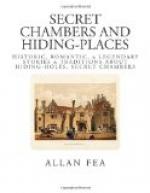[Illustration: INGATESTONE HALL, ESSEX]
[Illustration: INGATESTONE HALL]
An interesting discovery was made some years ago at Ingatestone Hall, Essex, the ancient seat of the Petres. The late Rev. Canon Last, who had resided there as private chaplain for over sixty years, described to us the incidents of this curious “find,” to which he was an eye-witness. Some of the floor-boards in the south-east corner of a small ante-room adjoining what was once “the host’s bedroom,” facing the south front, broke away, rotten with age, while some children were playing there. These being removed, a second layer of boards was brought to light within a foot of the old flooring, and in this a trap-door was found which, when opened, discovered a large “priest’s hole,” measuring fourteen feet long, ten feet high, and two feet wide. A twelve-step ladder led down into it, and the floor being on a level with the basement of the house was covered with a layer of dry sand to the depth of nearly a foot, so as to absorb any moisture from the ground.[1] In the sand a few bones of a bird were found, possibly the remains of food supplied to some unfortunate priest. Those who climb down into this hole will find much that is interesting to repay them their trouble. From the wall projects a candle-holder, rudely modelled out of clay. An examination of the brick-work in the interior of the “priest’s hole” proves it to be of later construction than the rest of the house (which dates from the early part of the sixteenth century), so in all likelihood “Little John” was the manufacturer.
[Footnote 1: At Moorcroft House, near Hillingdon, Middlesex, now modernised and occupied as a private lunatic asylum, ten priests were once concealed for four days in a hiding-place, the floor of which was covered some inches in water. This was one of the many comforts of a “priest’s hole"!]
Standing in the same position as when first opened, and supported by two blocks of oak, is an old chest or packing-case made of yew, covered with leather, and bound with bands of iron, wherein formerly the vestments, utensils, etc., for the Mass were kept. Upon it, in faded and antiquated writing, was the following direction: “For the Right Hon. the Lady Petre at Ingatestone Hall, in Essex.” The Petres had quitted the old mansion as a residence for considerably over a century when the discovery was made.
[Illustration: PRIEST’S HOLE, SAWSTON HALL]
CHAPTER VI
COMPTON WINYATES, SALFORD PRIOR, SAWSTON, OXBURGH, PARHAM, PAXHILL, ETC.




